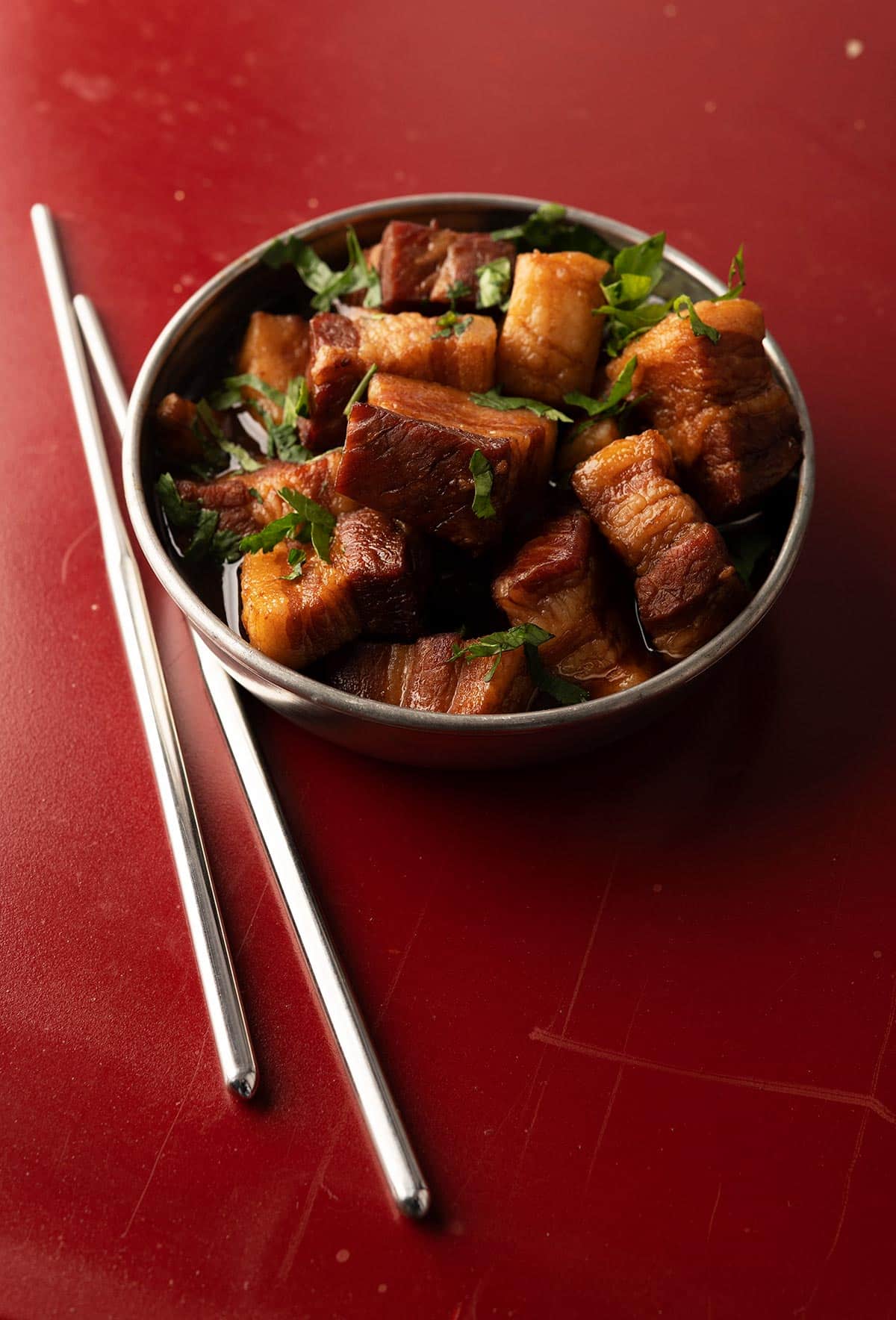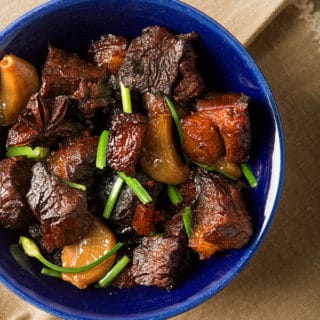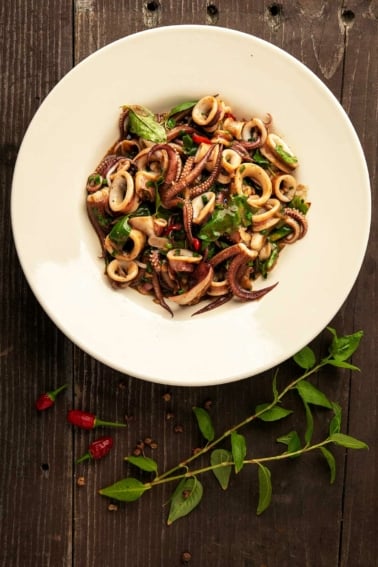As an Amazon Associate I earn from qualifying purchases.
Chinese red pork, also called red cooked or red braised pork, is so easy to make and so satisfying that I am shocked that it hasn’t made to the canon of Chinese American restaurant menus.
After all, it’s long braised pork belly or shoulder, with soy sauce, spices and a little sugar. So you get meaty-salty-fatty-sweet, and sometimes spicy all in the same dish. What’s not to love?

I grew up eating Hunan food at a local Chinese place in Garwood, New Jersey. Spicier, deeper in flavor and more exotic than the traditional Cantonese food most places served. Hands down, Hunan and the even spicier Sichuan food are my favorite styles of Chinese.
But never did I see Chinese red pork in any form — or any other red cooked dishes, for that matter.
In recent years, however, I’ve made countless Hunan and Sichuan dishes at home, and I’ve studied the cuisine a fair bit, from books and from my friend Kho Kian Lam’s excellent blog Red Cook, Adventures from a Chinese Home Kitchen. Kian knows his stuff when it comes to red cooking — he named his whole site after the style. I’ll let Kian explain it:
Red cooking is the basis of many Chinese home cooking. It is a term used for braising different kinds of food with garlic, dark soy sauce, rice wine and sugar. This technique can be used for pork, chicken, fish, tofu and many other ingredients. The phrase “red cook” comes from the fact that these dishes result in a shiny bright brown sauce appearing almost red. It is one of the most versatile techniques in Chinese cooking. And I’ve decided to name my blog for this technique to emphasize its flexibility and adaptability.
Red cooking need not even be with meat or fish. You will see red cooked tofu, and I happen to love red braised mushrooms.
In America, you will most often see red braised pork belly. This recipe is based on that one, and can be done with store-bought pork or wild ingredients, specifically wild pigs and bear. Yes, bear. Black bears can be so fat you can sometimes make bacon out of the belly, or you can make this.
Like many of the recipes on this site, this is the sort of family favorite where there are as many recipes as families. Some put chiles in, some not. Ditto for star anise. I’ve seen malt syrup used and rock sugar, simple granulated and no sugar at all.
Usually, however, any rendition of Chinese red pork is simple: The meat and maybe one or two other things going on, plus some greenery for garnish. It’s served over simple steamed rice; jasmine is my favorite here.

No matter if you use pork belly from the store, from a wild hog or bear you’ve brought home or whatever, you’ll want to make this recipe. Why? This bowl of food has it all: Fatty goodness, meltingly tender meat, a sweet-savory-salty-spicy sauce reduced from the braising liquid — all with a whiff of exotic anise — bright, crunchy green onions (or better yet, Chinese garlic chives), herbal cilantro and, for my touch, garlic.
I’m not gonna lie to ya, Holly and I ate nearly full two pounds of red braised pork between us. At one sitting. Make this. You won’t be sad.
Chinese Red Braised Pork
Ingredients
- 2 pounds pork, or bear belly
- 2 tablespoons sugar
- 3 tablespoons soy sauce
- 1/4 cup Chinese Shaoxing cooking wine (or sherry)
- 2 cups Chinese stock, chicken stock or water
- A 1-inch piece of ginger, sliced thin
- 3 star anise pods (optional)
- 4 dried hot chiles
- 5 scallions, sliced into 1-inch pieces
- 1/2 cup chopped cilantro
OPTIONAL GARLIC ADDITION
- 1 to 2 heads garlic, peeled but whole
- 2 tablespoons lard or peanut oil
Instructions
- Bring a large pot of water to a boil. Boil the whole slab of belly for 5 minutes. Remove from the water and set on a cutting board to cool. Save the cooking water if you are not using stock later for this recipe. Cut the meat into largish cubes of about 2 inches across.
- Mix the sugar with 3 tablespoons water until the sugar has dissolved. In a wok, heat the syrup over medium heat until begins to turn yellow, about 5 minutes or so. Add the par-cooked pork belly and turn to coat with the syrup mixture. Stir-fry until nicely browned.
- Pour in the Shaoxing wine, soy and enough stock or cooking water to cover the meat, and add the star anise, ginger, and chiles. Cover and simmer gently over medium-to-low heat. How long? Until the meat is tender. Typically about 90 minutes, but for a wild hog or bear this could take up to 3 hours. Check after 90 minutes. Taste the stock and if it is getting too strong, remove some of the spices.
- If you are adding the garlic to this dish, fry the garlic cloves in lard or peanut oil until they are nicely golden, then remove and set aside.
- Once the meat is getting tender – but not quite ready – add a little sugar if you want. The stock should be a bit sweet. Re-cover and cook until the pork is practically falling apart. Remove the meat and set aside. Turn the heat up on the sauce to reduce it. When the stock has reduced to a sauce consistency, return the meat to the pot and add the garlic, if using.
- Add the scallions and cilantro and serve at once. I prefer to eat this with simple steamed jasmine rice.
Video
Notes
Nutrition
Nutrition information is automatically calculated, so should only be used as an approximation.






Didn’t cook this, just expressing thanks for your article. Great to see confirmation that this dish can work with boar meat. The older Chinese guys in my extended family also eat red cooked pork as a kind of bar snack, alternating bites of meat with sips of Chinese white liquor. It’s as strong as it sounds and definitely an acquired taste! Try it if you dare 😉
I haven’t made your version of this yet but an old friend from college (He was from Hong Kong) had given me a recipe for char siu pork ribs that he had adapted for what ingredients he had available. As an experiment I used the marinade/sauce from his recipe on some venison ribs I was going to put in the slow cooker and the results were spectacular. Tender, tasty and so good we had none left! Dad had me make it twice a year after that. I can just imagine it with bear.
Oh my God. This was amazing. Everyone in my family, ages 1 to 43, LOVED it and couldn’t get enough. We even went light on the sugar, and used an old vermouth that was starting to get vinegary (because we had run out of sherry vinegar). Pork shoulder combined with cabbage sautéed in some of the sauce and white rice, and a beautiful natural Rosé. Hank never ceases to amaze us.
Absolutely incredible. I had this tonight, garnished with sliced jalapenos with brown rice and your pickled mustard greens. I don’t know if I’d pair those greens with it again. Too much star anise for one meal, but I will definitely make this dish again and again and ….
I’ve made this a few times now and just made it for a group of friend’s last night. It makes for an easy dinner inclusion because of how relatively off-hands it is in the second half of cooking, giving you time to focus on other items. Everyone raved about it and I don’t see how anyone could not love this dish.
The fat appears to be a requirement in this dish. The wild pigs I harvest in N. FL & S. GA are very lean with little to no fat. Do I need to use a different meat, add some fat (olive oil?)? Want to try it.
Greg: I’ve done this with wild hogs, but never with ultra lean ones. Maybe try it with the bellies nonetheless? They will take about twice as long to get tender as farmed pigs, and I would do most of this extra cooking in that simmering pot of water first.
I used the recipe on domestic pork shoulder and amped up the spice with a few finely cut Thai bird’s eye chili’s and added a bit of amaretto while I was deglazing. Holy tasty spicy Batman this is good. I am going to be making this regularly forever I think. Excited to do it with boar next time.
Made this with pork belly last night. Turned out to have fabulous flavours. Unexpected bonus was making the skin into crackling as an appetizer.
Some questions:
Is the sherry substituting the chinese cooking wine a dry sherry? Any particular type or brand you’d suggest using? And do you keep the skin on the pork belly or remove it before cooking?
Kristine: Either way with the skin. If you leave it on, it will take a bit longer to cook overall, because you want the skin to be soft. For sherry, look for a medium sherry, or even cooking sherry. An oloroso is too sweet, a fino too dry.
Oh my goodness. I worked with the Vietnamese community for years, and would eat this regularly. It was and is one of my absolute favorite dishes. I saw it made many times but the recipes were tightly guarded. Can not wait to try it. And yes, the fat was always plentiful, and delicious.
Hank, in the quote you have imbedded , the author calls for dark soy sauce: “Red cooking is the basis of many Chinese home cooking. It is a term used for braising different kinds of food with garlic, dark soy sauce, rice wine and sugar.” In my pantry, I have regular soy sauce, tamari, light soy sauce, and dark or black soy sauce. Dark soy has a very different flavor than standard soy sauce–it has a slight molasses sweetness. In your recipe, you call for soy sauce, and not dark soy. Have you tried it with dark soy sauce?
Zora: Yes, I use it a lot. Sounds like you are a soy expert! In that case, go for 1 or 2 tablespoons of dark, 2 or 3 of light soy sauce.
I’m not afraid of eating a fair amount of fat, but the picture shows pieces that are 75% fat! Did you actually eat that?
Allen: Of course. You’ve never eaten pork belly before? And if that’s too much fat for you, use shoulder as I suggest.
I did this with some raccoon because I’m all about eating everything I kill. It was amazing! Raccoon is totally different than other game meats like deer in that it isn’t that lean so it was perfect for this dish.
Made this with a fat wild-hog belly yesterday. Another hit! Very different from much of the cooking I’m accustomed to, these Asian recipes that Hank is sharing are really inspiring me to broaden my culinary horizons. Thanks, Hank!
Could you I pork shoulder or maybe you could suggest another appropriate cut? We made it with pork belly and it was delicious, but way too fatty, and I’m not usually someone to shy away from fat.
Kelly: It’s homemade stock (chicken, beef, etc) flavored with ginger and star anise. It’s not as vital to this recipe as is everything else, so I’d just go with whatever good stock you have around: Beef or chicken will be fine.
What is Chinese stock? Something I can make, hopefully, as Chinese packaged foods are pretty scarce in these parts…
After recently reading Rinella’s “Meat Eater” where he praises bear fat I have been planning to render the fat from our next black bear. Bear bacon is now added to ‘the list’ of things to try.
Interesting timing – last night I attempted to recreate a pork belly and garlic bolt dish I ate years ago. While at college, my wife and I stopped in at a Hunan restaurant in Vancouver and it blew my mind, and our taste buds – it is a SPICY cusine. Wildly different than the Hong Kong style we associate with Chinese food. I’m going to have to check out that cook book!